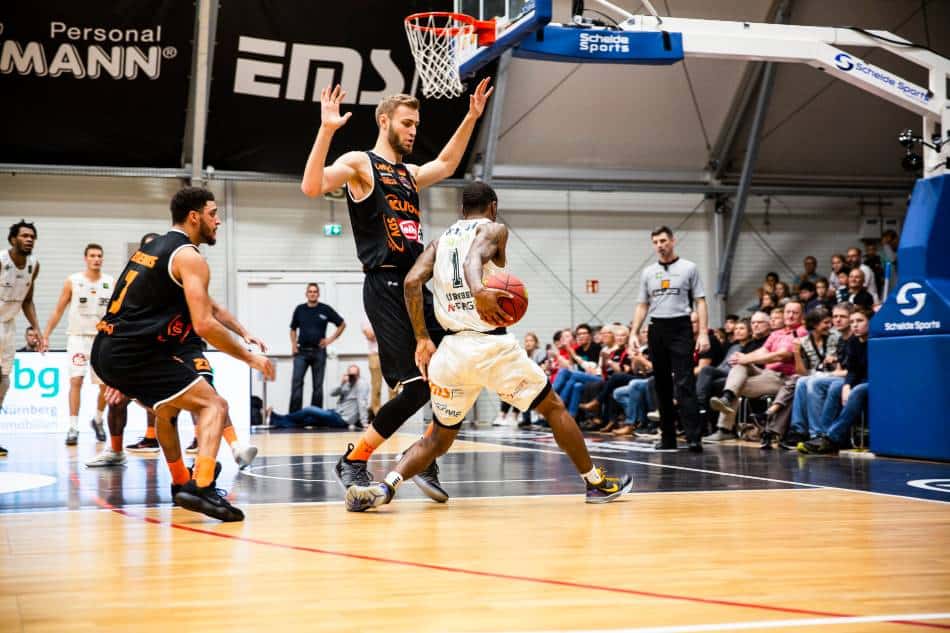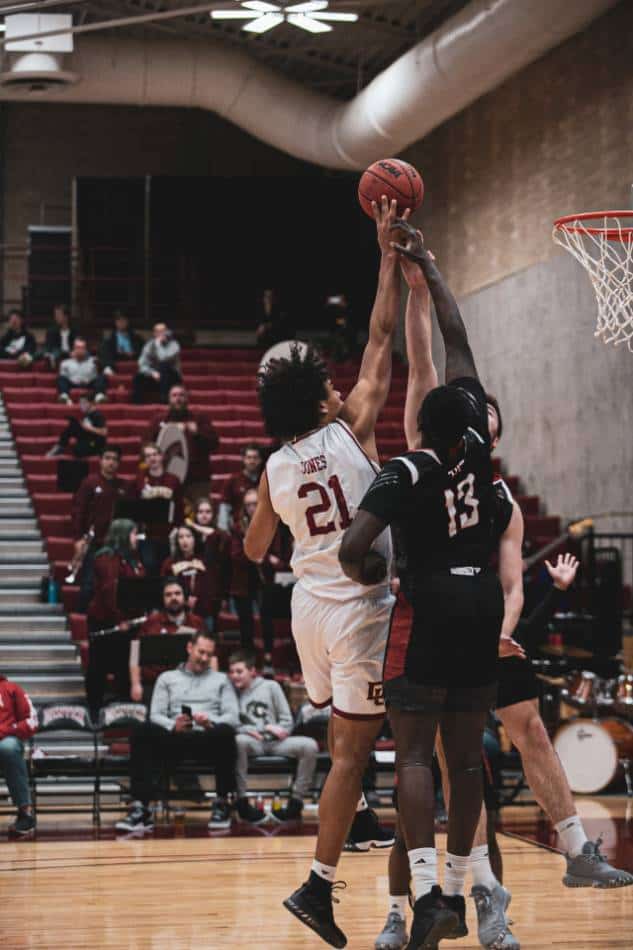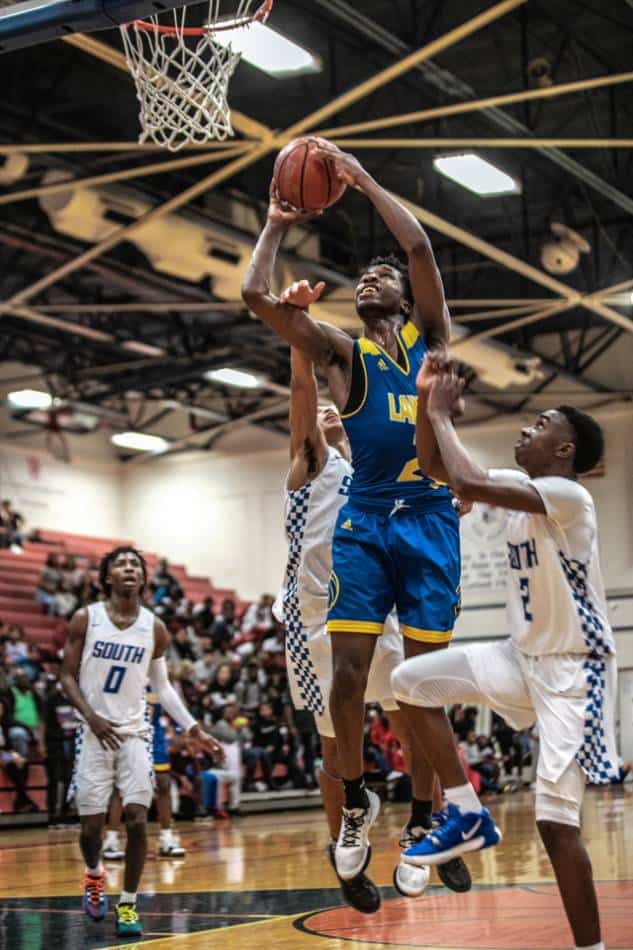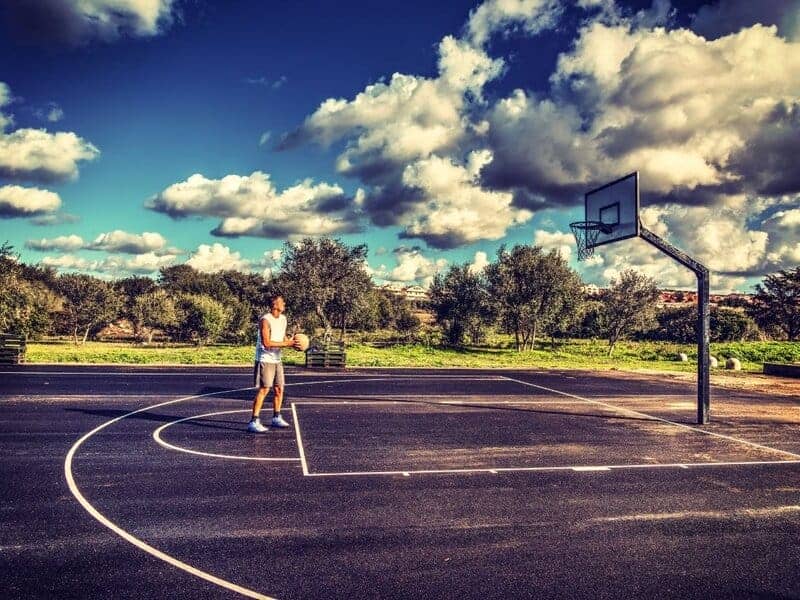
While there are a lot of things that go right on the basketball court, there are also a lot of things that go wrong. It doesn’t matter how much you try to avoid them, fouls are inevitable in the game of basketball and are often the deciding factor between a win or a loss.
So, what is a foul in basketball?
A foul is any action against the offense or defense that results in unnecessary contact. Every foul leads to a penalty, though the penalty varies depending on the type of foul. Fouls are categorized as offensive or defensive and are broken down into personal, team, technical, and flagrant fouls.
There are dozens of fouls that a referee calls in a game. They happen quickly and they happen often, so it’s important to understand the rules as much as possible to avoid committing fouls yourself.
Don’t worry, we’re going to break down everything you need to know about fouls in basketball, as well as how to avoid them on the offensive and defensive ends.
What Is a Personal Foul in Basketball?
The first type of foul is the personal foul, which is a foul against a specific player. Like we mentioned above, a foul is when a player makes illegal personal contact with another player. Therefore, a personal foul is what’s given to the player that committed the foul.
Receiving a personal foul in basketball is a big deal because in the NBA each player is only given six before being disqualified from the game — also known as ‘fouling out.’
In college, it’s five fouls. Every foul becomes more important than the last as the game goes on.
Personal fouls only count during the game they were committed. Once the game is over, each personal foul is recorded as a statistic. These fouls won’t follow players to their next game but they don’t reset until the game ends.
It’s often said that players should prepare to receive at least three personals called on them every game. That’s not to say you’re guaranteed to be called for three, but these three instances happen often and there’s a good chance they’ll happen to you. They are:
- Receiving a foul that’s clearly a bad call by the ref, but you can’t do anything to change it.
- Receiving a foul for illegal contact (charge or a block).
- Receiving a foul on purpose for strategic reasons.
It’s good practice to chalk yourself up for a combination of these three fouls before the game even starts. It helps you rethink the way you play the rest of the game because you’re more careful with the ball and won’t take risks unless they’re worth it.
Of course, there will always come a time when you have to be aggressive. That’s why it’s important to find a balance. Foul when you have to and foul when it makes sense, that way you don’t put yourself in a tight position down the stretch when you need to foul strategically.
What Is a Team Foul in Basketball?

Now that we understand what a personal foul is, it’s time to learn what a team foul is. The two are very similar to each other, yet they hold completely different purposes during a basketball game and should be treated as such.
The reason so many people get confused when discussing the differences between the two is that all team fouls are personal fouls. At the same time, not all personal fouls are team fouls and they don’t follow the same rules either. Let me explain.
A team foul is a personal foul that was committed by the defense. It’s what makes fouls by the defense so cringe-worthy because they count against the player and the team. Personal fouls committed on offense are known as just that — personal fouls.
Much like how each player gets six personal fouls before being disqualified, each team only gets five team fouls a half before a penalty is assessed.
After a team’s fourth team foul, any personal foul (offensive or defensive) results in the fouled player earning free throws, which is known as being in the ‘bonus.’
In college basketball, they take it a step further and award a double bonus to a team when their opponent reaches ten team fouls in one half. The college bonus works differently and gives the team a 1-and-1, which is where they get a second free throw only if they make the first.
If they miss the first one, the ball is live. The double bonus, however, is when the fouled player is awarded two free throws regardless (in college).
To summarize, personal fouls on defense are viewed as a ‘double whammy’ because they add to your game total and the team’s quarter total in terms of fouls. Keep in mind that college basketball doesn’t play quarters and instead plays halves.
With that being said, college team fouls reset each half – NBA is every quarter. If you want to keep yourself and your team in a good position to win, avoid those fouls — both offensive and defensive!
What Is a Shooting Foul in Basketball?
A shooting foul occurs when a defensive personal foul (also known as a team foul) is committed during the act of shooting. Shooting fouls always result in free throws for the fouled player, whether or not the team is already in a bonus.
When a shooting foul happens inside the three-point line (either a shot, layup, floater, or dunk), the fouled player is awarded two free throws to make up for the two points they would’ve had a chance at without the foul.
Likewise, a shooting foul that occurs outside of the three-point line awards three foul shots.
If the shooter makes the shot as they get fouled, the basket counts as long as it happened in the same motion as the foul. To make up for the foul, the shooter is also awarded one free throw for a chance at a three-point or four-point play. This is called an and-one.
Recently, the NBA changed a rule that requires the defender to give a shooter enough space to land after shooting. If the defender makes any contact with an opponent while they’re still in the air, it’s likely to be called a foul.
The new rule has caused the four-point play to become much more common than it used to be.
What Is a Technical Foul in Basketball?

Technical fouls, also known as a “T” or a “tech”, is one of the harshest penalties handed out in a basketball game. It’s given to a player on the court, a player on the bench, or even the coach if they are acting out of control.
For the most part, a technical foul is the result of unsportsmanlike conduct. Each technical foul generally falls into one of six different categories, which we’ll explain in more detail below:
- Excessive Timeouts – calling a timeout when you don’t have any remaining results in a technical foul being called on the coach. A free throw is awarded to the opposing team and the team that shoots the free throw gets the ball afterward.
- Delay of Game – any unnecessary action that results in the game being delayed, such as a player preventing another player from inbounding the ball, ends in a technical foul being assessed. Even actions that result in a one-second delay can be called a technical.
- Number of Players – having six or more players on the court is illegal for any team. Doing so results in a technical foul being called.
- Basketball Rim – using the rim or backboard to your advantage to stay balanced or jump higher is a technical foul. In addition to that, players can’t deliberately hang on the basketball net for an extended period.
- Conduct – much like any sport, players need to know how to carry themselves and how to properly represent the NBA and the rest of their team. Any unsportsmanlike conduct is bound to be given a technical foul, if not a warning.
- Fighting – in addition to unsportsmanlike conduct, fighting is not allowed on the basketball court. This includes both verbal and physical fights between players, coaches, or refs.
There are a lot of reasons why a referee might call a technical foul and it’s ultimately up to them to assess them as needed. For a majority of the rules above, the referee has the option to assess a warning before assessing a technical.
When a technical is assessed — in most situations — the opposing team is rewarded with a free throw and possession of the ball. As you accumulate technical fouls throughout the season, the fines get worse the more technical fouls you receive.
Eventually, a suspension could be assessed once enough technical fouls are earned. Fines are even worse in the playoffs.
Whether you’re a player or coach, receiving two technicals in the same game results in an ejection from that game. It doesn’t matter how bad those fouls are as long as they’re both technicals.
What Is a Flagrant Foul in Basketball?
When it comes to fouls, none are more aggressive than flagrant fouls. They aren’t called as often as other fouls, but they certainly cause emotion when they’re called.
Flagrant fouls are deemed excessive, unnecessary, or intentional. It’s always a tough call to make for the referee and normally requires a second look via a video replay to confirm the intent behind the illegal contact.
Even when a foul is a flagrant foul, the referee has to determine whether it’s a ‘Flagrant Foul 1’ or ‘Flagrant Foul 2’. The difference between the two can change the course of a game, making it a difficult call for the referee.
A flagrant foul 1 is called when the foul is deemed as unnecessary, but not overly-excessive. A flagrant foul 2 is called when the foul is deemed as both unnecessary and excessive. Committing a flagrant foul 1 twice results in an ejection while committing a flagrant foul 2 once results in an ejection.
In addition to the ejections, flagrant fouls result in the other team getting free throws and possession of the ball — which is a major plus.
The players that commit the foul are generally met with a fine or suspension, depending on how excessive it is.
Offensive Fouls in Basketball

As the name suggests, offensive fouls are fouls committed on the offense. For the most part, they are called when the offense illegally impedes the defense’s ability to do what they need to do. There will always be physical contact involved.
Let’s take a look at the five most prominent offensive fouls called in the NBA:
- Charging – this foul is called when an offensive player runs into a defensive player that has his feet set and standing still. The defensive player generally falls back to try and sell the call.
- Illegal Screen – if an offensive player sets a screen while still moving, the referee calls an illegal screen and possession of the ball changes.
- Holding – this foul is called on both the offense and defense. It occurs when a player deliberately holds another player to take away their motion.
- Elbowing – anytime a player elbows another player, the referee calls a personal foul. While it happens on both sides of the ball, the offense is prone to being called for elbowing when creating space for themselves or driving to the basket.
- Over the Back – this foul is usually called when going up for an offensive rebound. It’s when a player reaches over the back of the defender to grab a rebound.
Offensive fouls don’t occur as often as defensive fouls, but they’re just as heartbreaking. When you commit an offensive foul, you give up possession of the ball and forfeit the opportunity to score. The penalty is even worse if the opposing team is in the bonus, which results in possession of the ball for them, in the form of free throws.
The best way to avoid an offensive foul is to play your game — not the game your defender wants to play. Stay focused on the play and hone in on your responsibilities.
When you do that, you force the defense to make a move and risk committing a foul.
Defensive Fouls in Basketball
On the other hand, defensive fouls are called often in basketball. They’re mostly called when the defense uses excessive force to stop the offense and to throw them off-guard. In other instances, like the blocking foul, the defense is simply trying to draw a charge, but it doesn’t work.
Let’s take a look at five of the most prominent fouls called on the defense in the NBA and other basketball leagues around the world:
- Hand Check – this foul is often called ‘illegal use of hands’ and is called when a defensive player uses their hands to commit illegal contact with an opponent. It’s usually a tough call for the referee to make because there’s always a lot of back-and-forth between players.
- Reaching In – while the defense wants to try and steal the ball from the offense, they can’t force it by making contact with the offensive player. If they get ‘all-ball’, then the referee won’t call it a foul.
- Tripping – this is a foul in pretty much any sport and is universally viewed as unnecessary. It’s called on both the offense and defense, but usually occurs during a loose ball situation.
- Blocking Foul – this foul is often called when a defensive player is trying to force a charge. To make contact with an offensive player, the defense has to get set first. If they’re not set, it’s called a foul.
- Pushing – the defense is normally taught to play tight defense, but this backfires from time to time. Since the game of basketball happens so quickly, sometimes playing tight defense results in a push.
Since defensive fouls also count towards the team foul count, it’s best to avoid these types of fouls as much as possible. There are times when a defensive foul is needed, especially late in the game when you want to stop the clock.
Knowing when to foul is a skill not many players have these days. Instead, the NBA today sees a lot of players deliberately trying to get fouled and flopping on the floor.
Unfortunately, this takes away from the game of basketball and referees don’t allow it — so much so that excessive flopping is a foul in itself.
What Is a Free Throw in Basketball?

The free throw also called the ‘foul shot’ and the ‘charity stripe’, is the best friend of any offensive player. It’s the only play in the entire game of basketball that the offensive player has full control over. It’s also the one shot every single player should be good at.
Free throws are awarded to an offensive player when a shooting foul occurs. Since they’re fouled while attempting a shot, free throws are meant to give them back their scoring opportunity. They’re also rewarded to the defense when in the bonus.
When you look at the paint area, you notice four hashes on each side of the rectangle. Those hashes represent where the players line up while a player is shooting a free throw. They must remain outside the paint area until the ball leaves the shooter’s hand.
The actual free throw line is 15 feet from the basket. Players have a 12-foot wide line to shoot from, but they normally choose to shoot from the middle of it. Players also have ten seconds to shoot the ball before forfeiting the shot.
You’re either awarded one free throw, two free throws, or three free throws. At most, a free throw results in a four-point play — if the shooter is fouled while making a three-pointer.
Since you don’t face resistance from the defense when shooting a free throw, you should aim to shoot no lower than 80% from the free throw line. In some cases, the free throw shooter gets to shoot their free throw without anyone on the hashes.
This is typical of a technical foul.
Fouls and Violations in Basketball
Now that you understand what a foul is, it’s important you also understand what a violation is. Contrary to popular belief, there is a difference between fouls and violations. Unfortunately, many people create confusion by using fouls and violations interchangeably.
Like we discussed above, a foul generally involves illegal personal contact between two players. A violation, on the other hand, involves an illegal action with the ball or court.
For example, the following are considered violations in basketball — as opposed to fouls:
- Traveling – when a player illegally moves their pivot foot or doesn’t establish the pivot foot properly.
- Palming – also called a ‘carry’, occurs when the player isn’t dribbling with their hand on top of the ball.
- Double Dribble – when a player dribbles after already picking up their dribble.
- Held Ball – when two players fight for the ball and neither player is giving way, it’s called a held ball or ‘jump ball’.
- Backcourt – when a player dribbles past half-court, that team isn’t allowed to bring the ball into the backcourt unless possession of the ball changes.
- Kicking – anytime a player kicks the ball, whether it be intentional or unintentional, the referee calls a stoppage of play.
- Free Throw Violation – if the offense steps in the paint area while shooting a free throw, the free throw doesn’t count. If the defense steps in the paint area while the other team is shooting a free throw, the offense gets another chance at the free throw.
- Three Second Violation – players aren’t allowed to stand in the key for more than three seconds when on offense.
- Five Second Violation – each offensive player has five seconds to do something with the ball when being heavily guarded. Players also have five seconds to inbound the ball before a play.
- Eight Second Violation – players have eight seconds to get the ball past half court after inbounding the ball.
- 24-Second Violation – the offense has 24 seconds to get a shot up in the air. If the ball hits the rim and they recover it, the shot clock resets to 14 seconds.
- Goaltending – if a defensive player blocks the ball or stops it from going in the basket after it has already started to descend, it’s a goaltend and the offense is awarded the points.
Violations generally occur on offense and lead to the possession of the ball changing, but there are some defensive violations as well. There won’t, however, be any free throws awarded for a violation — which is one of the main differences between a fouls and violations.
